Lipid Oxidation Changes of Arabica Green Coffee Beans during Accelerated Storage with Different Packaging Types
Abstract
1. Introduction
2. Materials and Methods
2.1. Sample Preparation
2.2. Moisture Content (MC)
2.3. Water Activity (aw)
2.4. Color Determination
2.5. Lipid Oxidation Determination
2.5.1. Lipid Content
2.5.2. Determination of Acid Value (AV) and Free Fatty Acid (FFA)
2.5.3. Determination ρ-Anisidine Value (PAV)
- As = the absorbance of the fat solution after reaction with ρ-anisidine reagent
- Ab = the absorbance of the fat solution.
2.5.4. Peroxide Value (PV)
2.5.5. Total Oxidation Value (TOTOX)
2.5.6. Measurement of Thiobarbituric Acid Reactive Substances (TBARS)
2.5.7. Fatty Acid Profile
2.6. Statistical Analysis
3. Results and Discussion
3.1. Effect of Accelerated Storage on Change of GCB Qualities
3.2. Effects of Accelerated Storage Conditions on GCB Lipid Oxidation
3.3. Effects of Accelerated Storage Conditions on GCB Fatty Acid Profile
3.4. Principle Component Analysis (PCA)
3.5. Agglomerative Hierarchical Clustering (AHC) Analysis
4. Conclusions
Supplementary Materials
Author Contributions
Funding
Data Availability Statement
Acknowledgments
Conflicts of Interest
References
- Bosselmann, A.S.; Dons, K.; Oberthur, T.; Olsen, C.S.; Ræbild, A.; Usma, H. The influence of shade trees on coffee quality in small holder coffee agroforestry systems in Southern Colombia. Agric. Ecosyst. Environ. 2009, 129, 253–260. [Google Scholar] [CrossRef]
- Angelino, D.; Tassotti, M.; Brighenti, F.; Del Rio, D.; Mena, P. Niacin, alkaloids and (poly)phenolic compounds in the most widespread Italian capsule-brewed coffees. Sci. Rep. 2018, 8, 17874. [Google Scholar] [CrossRef] [PubMed]
- Noppakoonwong, U.; Khomarwut, C.; Hanthewee, M.; Jarintorn, S.; Hassarungsee, S.; Meesook, S.; Daoruang, C.; Naka, P.; Lertwatanakiat, S.; Sataawut, K.; et al. Research and development of Arabica coffee in Thailand. In Proceedings of the 25th International Conference on Coffee Science (ASIC), Armenia-Quindío, Colombia, 8–13 September 2014. [Google Scholar]
- Quiñones-Ruiz, X.F.; Nigmann, T.; Schreiber, C.; Neilson, J. Collective Action Milieus and Governance Structures of Protected Geographical Indications for Coffee in Colombia, Thailand and Indonesia. Int. J. Commons 2020, 15, 329–343. [Google Scholar] [CrossRef]
- Office of Agricultural Economics. Agricultural Statistics of Thailand 2018. Available online: http://www.oae.go.th/assets/portals/1/files/jounal/2562/yearbook2561.pdf (accessed on 1 August 2019).
- Lilavanichakul, A. PGI Doi Chaang Coffee in Thailand. In Sustainability of European Food Quality Schemes; Springer: London, UK, 2019; pp. 287–302. [Google Scholar]
- Lilavanichakul, A. The Economic Impact of Arabica Coffee Farmers’ Participation in Geographical Indication in Northern Highland of Thailand. J. Rural Probl. 2020, 56, 124–131. [Google Scholar] [CrossRef]
- Chuqian, W. A Study on the Situation and Development of the Coffee Industry in Thailand. Doctoral Thesis, Siam University, Bangkok, Thailand, 2018. [Google Scholar]
- Maman, M.; Sangchote, S.; Piasai, O.; Leesutthiphonchai, W.; Sukorini, H.; Khewkhom, N. Storage fungi and ochratoxin A associated with arabica coffee bean in postharvest processes in Northern Thailand. Food Control 2021, 130, 108351. [Google Scholar] [CrossRef]
- Abreu, G.F.; Borém, F.M.; Oliveira, L.F.C.; Almeida, M.R.; Alves, A.P.C. Raman spectroscopy: A new strategy for monitoring the quality of green coffee beans during storage. Food Chem. 2019, 287, 241–248. [Google Scholar] [CrossRef]
- Ribeiro, F.C.; Borém, F.M.; Giomo, G.S.; De Lima, R.R.; Malta, M.R.; Figueiredo, L.P. Storage of green coffee in hermetic packaging injected with CO2. J. Stored Prod. Res. 2011, 47, 341–348. [Google Scholar] [CrossRef]
- Tripetch, P.; Borompichaichartkul, C. Effect of packaging materials and storage time on changes of colour, phenolic content, chlorogenic acid and antioxidant activity in arabica green coffee beans (Coffea arabica L. cv. Catimor). J. Stored Prod. Res. 2019, 84, 101510. [Google Scholar] [CrossRef]
- Borém, F.M.; de Abreu, G.F.; Alves, A.P.D.C.; dos Santos, C.M.; Teixeira, D.E. Volatile compounds indicating latent damage to sensory attributes in coffee stored in permeable and hermetic packaging. Food Packag. Shelf Life 2021, 29, 100705. [Google Scholar] [CrossRef]
- Zarebska, M.; Stanek, N.; Barabosz, K.; Jaszkiewicz, A.; Kulesza, R.; Matejuk, R.; Andrzejewski, D.; Biłos, L.; Porada, A. Comparison of chemical compounds and their influence on the taste of coffee depending on green beans storage conditions. Sci. Rep. 2021, 12, 2674. [Google Scholar] [CrossRef]
- Borém, F.M.; Ribeiro, F.C.; Figueiredo, L.P.; Giomo, G.; Fortunato, V.A.; Isquierdo, E.P. Evaluation of the sensory and color quality of coffee beans stored in hermetic packaging. J. Stored Prod. Res. 2013, 52, 1–6. [Google Scholar] [CrossRef]
- Rendón, M.; Salva, T.D.J.G.; Bragagnolo, N. Impact of chemical changes on the sensory characteristics of coffee beans during storage. Food Chem. 2014, 147, 279–286. [Google Scholar] [CrossRef] [PubMed]
- Scheidig, C.; Czerny, M.; Schieberle, P. Changes in Key Odorants of Raw Coffee Beans during Storage under Defined Conditions. J. Agric. Food Chem. 2007, 55, 5768–5775. [Google Scholar] [CrossRef] [PubMed]
- Wintgens, J.N. Coffee: Growing, Processing, Sustainable Production. A Guidebook for Growers, Processors, Traders, and Researchers; WILEY-VCH Verlag GmbH & Co. KGaA: Weinheim, Germany, 2004. [Google Scholar]
- Cheng, B.; Furtado, A.; Smyth, H.E.; Henry, R.J. Influence of genotype and environment on coffee quality. Trends Food Sci. Technol. 2016, 57, 20–30. [Google Scholar] [CrossRef]
- De Bruyn, F.; Zhang, S.J.; Pothakos, V.; Torres, J.; Lambot, C.; Moroni, A.V.; Callanan, M.; Sybesma, W.; Weckx, S.; De Vuyst, L. Exploring the Impacts of Postharvest Processing on the Microbiota and Metabolite Profiles during Green Coffee Bean Production. Appl. Environ. Microbiol. 2017, 83, e02398-16. [Google Scholar] [CrossRef]
- Caporaso, N.; Whitworth, M.B.; Cui, C.; Fisk, I.D. Variability of single bean coffee volatile compounds of Arabica and robusta roasted coffees analysed by SPME-GC-MS. Food Res. Int. 2018, 108, 628–640. [Google Scholar] [CrossRef]
- Sai, A.M. Physicochemical Properties, and Aromatic Profile of Arabica Coffee in Ywangan Township, Myanmar. Master’s Thesis, Mae Fah Luang University, Chiang Rai, Thailand, 2020. [Google Scholar]
- Hough, G.; Garitta, L.; Gomez, G. Sensory shelf-life predictions by survival analysis accelerated storage models. Food Qual. Prefer. 2006, 17, 468–473. [Google Scholar] [CrossRef]
- De Bouillé, A.; Beeren, C. Sensory Evaluation Methods for Food and Beverage Shelf Life Assessment. In The Stability and Shelf Life of Food; Woodhead Publishing: Cambridge, UK, 2016; pp. 199–228. [Google Scholar]
- Cong, S.; Dong, W.; Zhao, J.; Hu, R.; Long, Y.; Chi, X. Characterization of the Lipid Oxidation Process of Robusta Green Coffee Beans and Shelf Life Prediction during Accelerated Storage. Molecules 2020, 25, 1157. [Google Scholar] [CrossRef]
- Speer, K.; Kölling-Speer, I. The lipid fraction of the coffee bean. Braz. J. Plant Physiol. 2006, 18, 201–216. [Google Scholar] [CrossRef]
- ASTM. Standard Test Method for Air Permeability of Textile Fabrics; D737-96; ASTM International: West Conshohocken, PA, USA, 1996; pp. 230–234. [Google Scholar]
- Official Methods of Analysis of AOAC International, 17th ed.; Official Method 979.12; AOAC International: Gaithersburg, MD, USA, 2000.
- Akbar, A.; Medina, A.; Magan, N. Resilience of Aspergillus westerdijkiae Strains to Interacting Climate-Related Abiotic Factors: Effects on Growth and Ochratoxin A Production on Coffee-Based Medium and in Stored Coffee. Microorganisms 2020, 8, 1268. [Google Scholar] [CrossRef]
- Wongsa, P.; Khampa, N.; Horadee, S.; Chaiwarith, J.; Rattanapanone, N. Quality and bioactive compounds of blends of Arabica and Robusta spray-dried coffee. Food Chem. 2019, 283, 579–587. [Google Scholar] [CrossRef] [PubMed]
- Official Methods of Analysis of AOAC International, 17th ed.; Official Method 920.39; AOAC International: Gaithersburg, MD, USA, 2000.
- Official Methods of Analysis of AOAC International, 5th ed.; Official Method 940.28; AOAC International: Gaithersburg, MD, USA, 1940.
- Official Methods of Analysis of AOAC International, 17th ed.; Official Method 965.33; AOAC International: Gaithersburg, MD, USA, 2000.
- Nielsen, S.S. Preparation of fatty acid methyl esters (FAMEs) and determination of fatty acid profile of oils by gas chromatography. In Food Analysis Laboratory Manual; Kluwer Academic: New York, NY, USA, 2003. [Google Scholar]
- David, F.; Sandra, P.; Vickers, A.K. Column selection for the analysis of fatty acid methyl esters. In Food Analysis Application; Agilent Technologies: Palo Alto, CA, USA, 2005; p. 19. [Google Scholar]
- Erdawati, R. Effect of nanocomposite-based packaging on postharvest quality of water content-treated coffee beans during storage. In Proceedings of the ICBB (The International Conference on Bioscience and Biotechnology), Yogyakarta, Indonesia, 11–12 October 2011; Volume 1, pp. A6–A15. [Google Scholar]
- Macedo, L.L.; Araújo, C.D.S.; Vimercati, W.C.; Hein, P.R.G.; Pimenta, C.J.; Saraiva, S.H. Evaluation of chemical properties of intact green coffee beans using near-infrared spectroscopy. J. Sci. Food Agric. 2021, 101, 3500–3507. [Google Scholar] [CrossRef] [PubMed]
- Gautz, L.D.; Smith, V.E.; Bittenbender, H.C. Measuring Coffee Bean Moisture Content. 2008. Available online: https://scholarspace.manoa.hawaii.edu/bitstream/10125/12221/EN-3.pdf (accessed on 11 November 2020).
- Adnan, A.; Von Hörsten, D.; Pawelzik, E.; Mörlein, A.D.; Mörlein, D. Rapid Prediction of Moisture Content in Intact Green Coffee Beans Using Near Infrared Spectroscopy. Foods 2017, 6, 38. [Google Scholar] [CrossRef] [PubMed]
- Reh, C.; Gerber, A.; Prodolliet, J.; Vuataz, G. Water content determination in green coffee—Method comparison to study specificity and accuracy. Food Chem. 2006, 96, 423–430. [Google Scholar] [CrossRef]
- Palacios-Cabrera, H.A.; Menezes, H.C.; Iamanaka, B.T.; Canepa, F.; Teixeira, A.A.; Carvalhaes, N.; Santi, D.; Leme, P.T.Z.; Yotsuyanagi, K.; Taniwaki, M.H. Effect of Temperature and Relative Humidity during Transportation on Green Coffee Bean Moisture Content and Ochratoxin A Production. J. Food Prot. 2007, 70, 164–171. [Google Scholar] [CrossRef]
- Pittia, P.; Nicoli, M.C.; Sacchetti, G. Effect of moisture and water activity on textural properties of raw and roasted coffee beans. J. Texture Stud. 2007, 38, 116–134. [Google Scholar] [CrossRef]
- Garcia, D.; Ramos, A.J.; Sanchis, V.; Marín, S. Modelling the effect of temperature and water activity in the growth boundaries of Aspergillus ochraceus and Aspergillus parasiticus. Food Microbiol. 2011, 28, 406–417. [Google Scholar] [CrossRef] [PubMed]
- Agudelo, Y.M. An Introduction to Water Activity in Green Coffee 2021. Available online: https://dailycoffeenews.com/2021/06/23/an-introduction-to-water-activity-in-green-coffee/ (accessed on 20 February 2022).
- Junqueira, A.C.D.O.; Pereira, G.; Medina, J.D.C.; Alvear, M.C.R.; Rosero, R.; Neto, D.P.D.C.; Enriquez, H.A.G.; Soccol, C.R. First description of bacterial and fungal communities in Colombian coffee beans fermentation analysed using Illumina-based amplicon sequencing. Sci. Rep. 2019, 9, 8794. [Google Scholar] [CrossRef]
- Pardo, E.; Ramos, A.J.; Sanchis, V.; Marın, S. Modelling of effects of water activity and temperature on germination and growth of ochratoxigenic isolates of Aspergillus ochraceus on a green coffee-based medium. Int. J. Food Microbiol. 2005, 98, 1–9. [Google Scholar] [CrossRef]
- Illy, A.; Viani, R. (Eds.) Espresso Coffee: The Science of Quality; Elsevier Science Publishing: Amsterdam, The Netherlands; Academic Press: Cambridge, MA, USA, 2005. [Google Scholar]
- Bicho, N.C.; Leitao, A.; Ramalho, J.C.; Alvarenga, N.; Lidon, F.C. Identification of Chemical Clusters Discriminators of Arabica and Robusta Green Coffee. Int. J. Food Prop. 2013, 16, 895–904. [Google Scholar] [CrossRef]
- Ferreira, L.F.; de Abreu, G.F.; Lago, A.M.T.; Figueiredo, L.P.; Borém, F.M.; Martins, M.A.; Borges, S.V.; Dias, M.V. Development and application of biopolymer coatings to specialty green coffee beans: Influence on water content, color and sensory quality. LWT 2018, 96, 274–280. [Google Scholar] [CrossRef]
- Calligaris, S.; Munari, M.; Arrighetti, G.; Barba, L. Insights into the physicochemical properties of coffee oil. Eur. J. Lipid Sci. Technol. 2009, 111, 1270–1277. [Google Scholar] [CrossRef]
- Yuwita, F.; Ifmalinda; Makky, M. Non-destructive Evaluation of Fat Content of Coffee Beans Solok Radjo Using Near Infrared Spectroscopy. IOP Conf. Ser. Earth Environ. Sci. 2019, 327, 012005. [Google Scholar] [CrossRef]
- Zhu, M.; Long, Y.; Chen, Y.; Huang, Y.; Tang, L.; Gan, B.; Yu, Q.; Xie, J. Fast determination of lipid and protein content in green coffee beans from different origins using NIR spectroscopy and chemometrics. J. Food Compos. Anal. 2021, 102, 104055. [Google Scholar] [CrossRef]
- Hou, H.J.; Chang, K.C. Storage conditions affect soybean color, chemical composition and tofu qualities. J. Food Processing Preserv. 2004, 28, 473–488. [Google Scholar] [CrossRef]
- Joët, T.; Laffargue, A.; Descroix, F.; Doulbeau, S.; Bertrand, B.; de Kochko, A.; Dussert, S. Influence of environmental factors, wet processing and their interactions on the biochemical composition of green Arabica coffee beans. Food Chem. 2010, 118, 693–701. [Google Scholar] [CrossRef]
- Odeny, D.A.; Chemining’wa, G.N.; Shibairo, S.I. Beverage quality and biochemical components of shaded coffee. In Proceedings of the 25th International Conference on Coffee Science, ASIC 2014, Armenia, Colombia, 8–13 September 2014; Association Scientifique Internationale du Café (ASIC): Paris, France, 2014. [Google Scholar]
- Al-Hamamre, Z.; Foerster, S.; Hartmann, F.; Kröger, M.; Kaltschmitt, M. Oil extracted from spent coffee grounds as a renewable source for fatty acid methyl ester manufacturing. Fuel 2012, 96, 70–76. [Google Scholar] [CrossRef]
- Muangrat, R.; Pongsirikul, I. Recovery of spent coffee grounds oil using supercritical CO2: Extraction optimisation and physicochemical properties of oil. CyTA J. Food 2019, 17, 334–346. [Google Scholar] [CrossRef]
- Liu, Y.; Tu, Q.; Knothe, G.; Lu, M. Direct transesterification of spent coffee grounds for biodiesel production. Fuel 2017, 199, 157–161. [Google Scholar] [CrossRef]
- Dong, W.; Chen, Q.; Wei, C.; Hu, R.; Long, Y.; Zong, Y.; Chu, Z. Comparison of the effect of extraction methods on the quality of green coffee oil from Arabica coffee beans: Lipid yield, fatty acid composition, bioactive components, and antioxidant activity. Ultrason. Sonochem. 2021, 74, 105578. [Google Scholar] [CrossRef]
- Panpraneecharoen, S.; Chumanee, S. Optimization of the oil extraction, study the chemical and physical properties of arabica spent coffee grounds. Sci. Technol. Asia 2020, 25, 12–19. [Google Scholar]
- Kocadağlı, T.; Göncüoğlu, N.; Hamzalıoğlu, A.; Gökmen, V. In depth study of acrylamide formation in coffee during roasting: Role of sucrose decomposition and lipid oxidation. Food Funct. 2012, 3, 970–975. [Google Scholar] [CrossRef]
- Hong, Q.; Dong, W. Exploration of the accelerated oxidation process and change rule of bioactive components from green coffee oil based on thermal induction. Chin. J. Trop. Crops 2021, 42, 3327. [Google Scholar]
- Budryn, G.; Nebesny, E.; Żyżelewicz, D. Oxidative stability of lard and sunflower oil supplemented with coffee extracts under storage conditions. Grasas Aceites 2011, 62, 155–161. [Google Scholar] [CrossRef][Green Version]
- Montavon, P.; Mauron, A.-F.; Duruz, E. Changes in Green Coffee Protein Profiles during Roasting. J. Agric. Food Chem. 2003, 51, 2335–2343. [Google Scholar] [CrossRef]
- Ahmed, M.; Pickova, J.; Ahmad, T.; Liaquat, M.; Farid, A.; Jahangir, M. Oxidation of Lipids in Foods. Sarhad J. Agric. 2016, 32, 230–238. [Google Scholar] [CrossRef]
- El-Anany, A.M.; Althwab, S.A.; Ali, R.F.; Mousa, H. Potential antioxidant and lipid peroxidation inhibition of coffee mixed with lemongrass (Cymbopogon citrates) leaves. Nutr. Food Sci. 2021, 51, 1194–1206. [Google Scholar] [CrossRef]
- Faria, W.C.S.; de Oliveira, M.G.; da Conceicao, E.C.; Silva, V.B.; Veggi, N.; Converti, A.; Barros, W.M.; Silva, M.F.; Bragagnolo, N. Antioxidant efficacy and in silico toxicity prediction of free and spray-dried extracts of green Arabica and Robusta coffee fruits and their application in edible oil. Food Hydrocoll. 2020, 108, 106004. [Google Scholar] [CrossRef]
- Acevedo, F.; Rubilar, M.; Scheuermann, E.; Cancino, B.; Uquiche, E.; Garces, M.; Inostroza, K.; Shene, C. Spent Coffee Grounds as a Renewable Source of Bioactive Compounds. J. Biobased Mater. Bioenergy 2013, 7, 420–428. [Google Scholar] [CrossRef]
- Dilnawaz, H.; Kumar, S.; Bhat, Z. Ipomoea batatas as a novel binding agent for hot-set restructured binding systems and green coffee bean for improved lipid oxidative stability and storage quality. Nutr. Food Sci. 2017, 47, 659–672. [Google Scholar] [CrossRef]
- Martın, M.J.; Pablos, F.; Gonzalez, A.G.; Valdenebro, M.S.; León-Camacho, M. Fatty acid profiles as discriminant parameters for coffee varieties differentiation. Talanta 2001, 54, 291–297. [Google Scholar] [CrossRef]
- Raba, D.N.; Poiana, M.-A.; Borozan, A.B.; Stef, M.; Radu, F.; Popa, M.-V. Investigation on Crude and High-Temperature Heated Coffee Oil by ATR-FTIR Spectroscopy along with Antioxidant and Antimicrobial Properties. PLoS ONE 2015, 10, e0138080. [Google Scholar] [CrossRef]
- Vu, D.C.; Vu, Q.T.; Huynh, L.; Lin, C.-H.; Alvarez, S.; Vo, X.T.; Nguyen, T.H.D. Evaluation of fatty acids, phenolics and bioactivities of spent coffee grounds prepared from Vietnamese coffee. Int. J. Food Prop. 2021, 24, 1548–1558. [Google Scholar] [CrossRef]
- Figueiredo, L.P.; Borem, F.M.; Ribeiro, F.C.; Giomo, G.S.; Taveira, J.; Malta, M.R. Fatty acid profiles and parameters of quality of specialty coffees produced in different Brazilian regions. Afr. J. Agric. Res. 2015, 10, 3484–3493. [Google Scholar]
- Tsegay, G.; Redi-Abshiro, M.; Chandravanshi, B.S.; Ele, E.; Mohammed, A.M.; Mamo, H. Effect of altitude of coffee plants on the composition of fatty acids of green coffee beans. BMC Chem. 2020, 14, 36. [Google Scholar] [CrossRef]
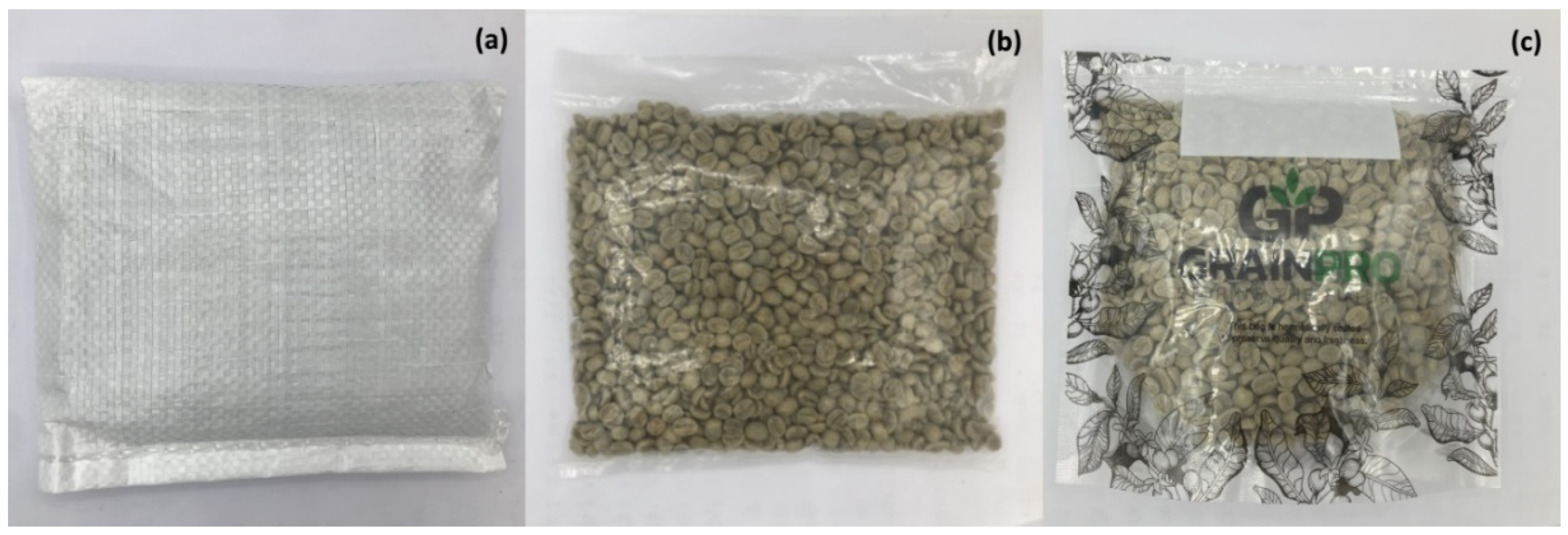
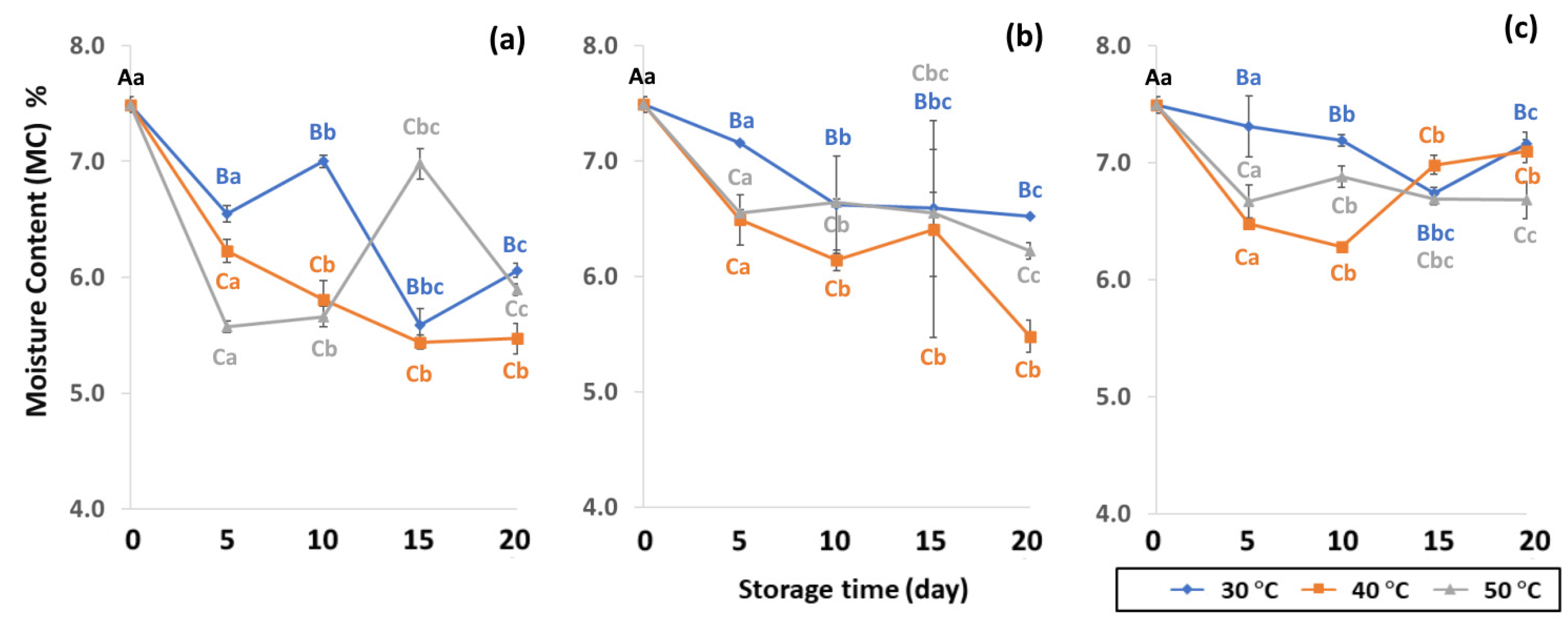
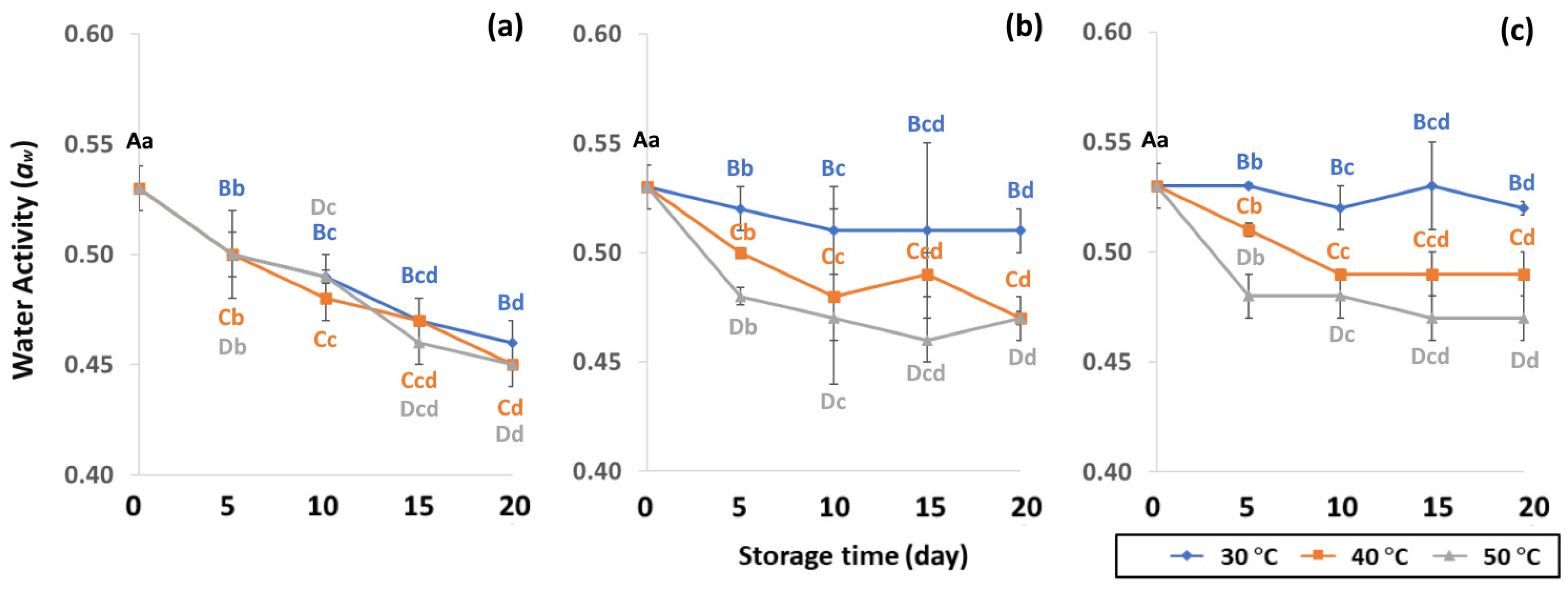
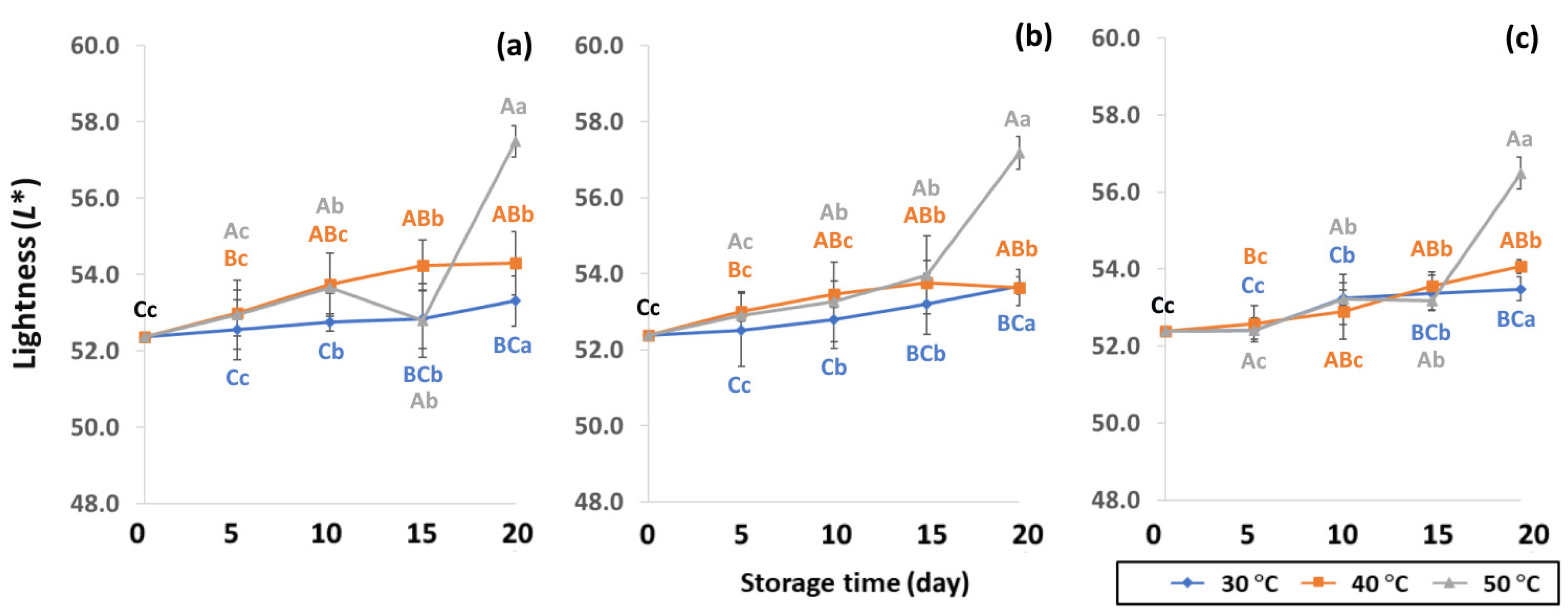
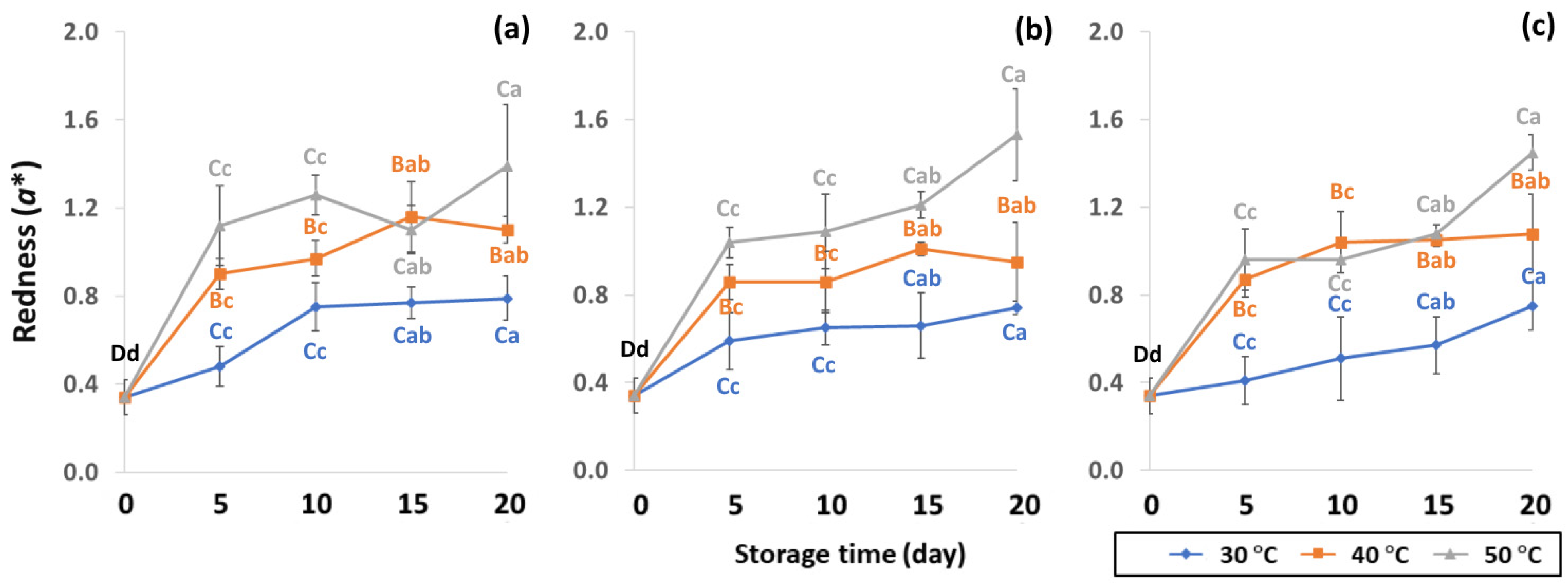
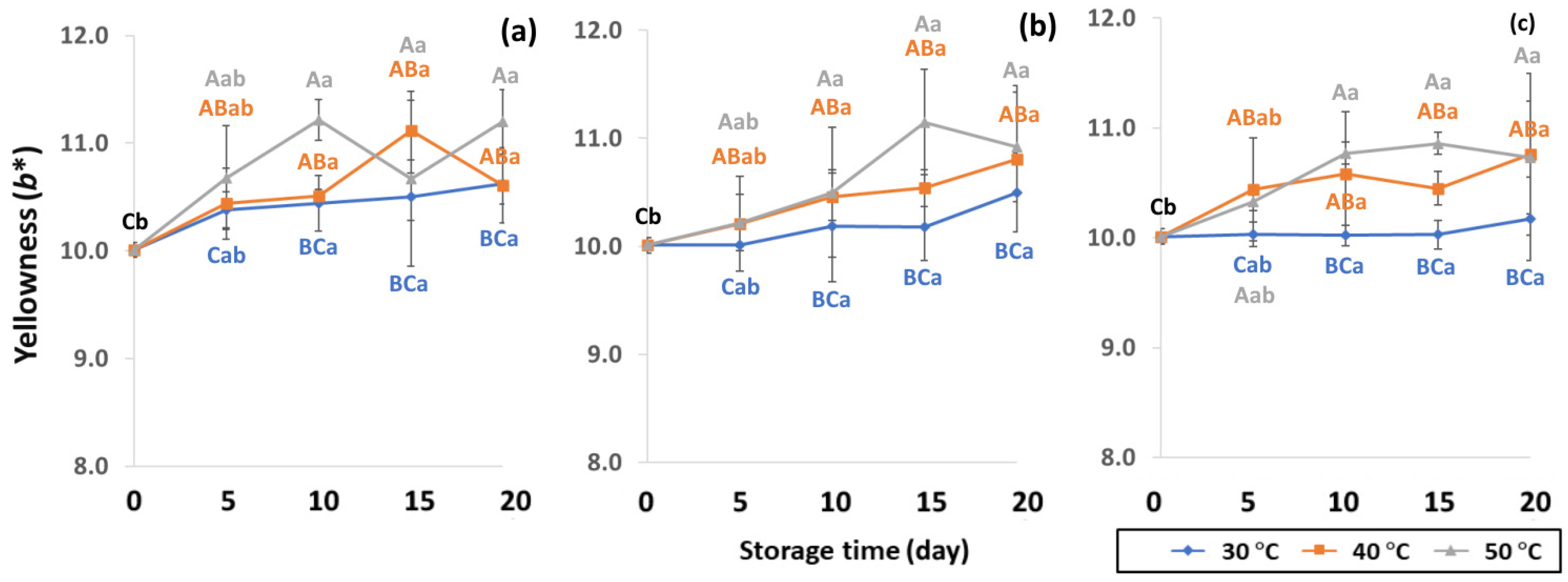
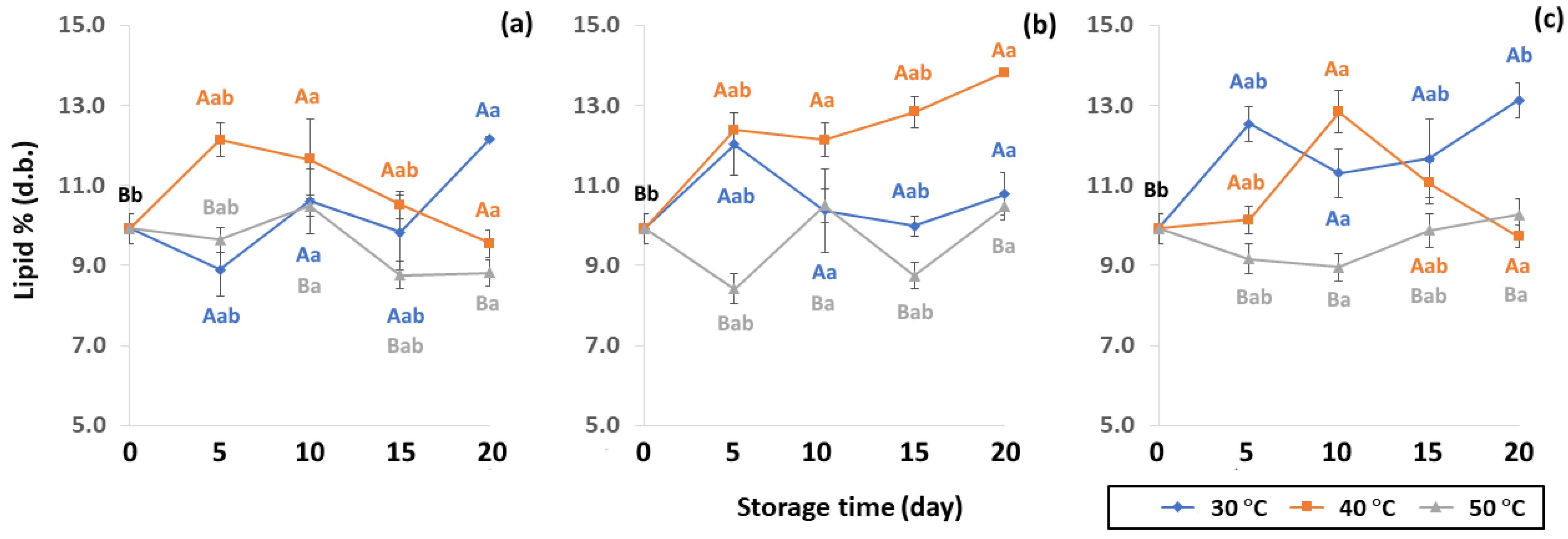

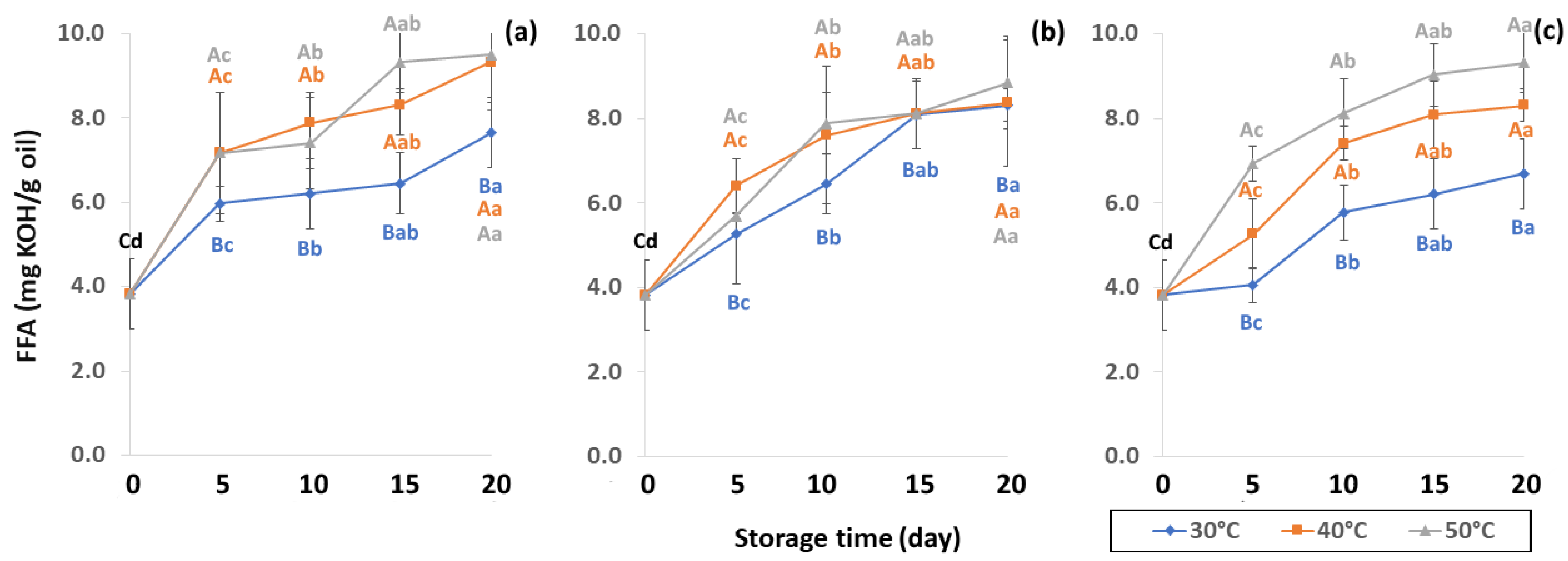
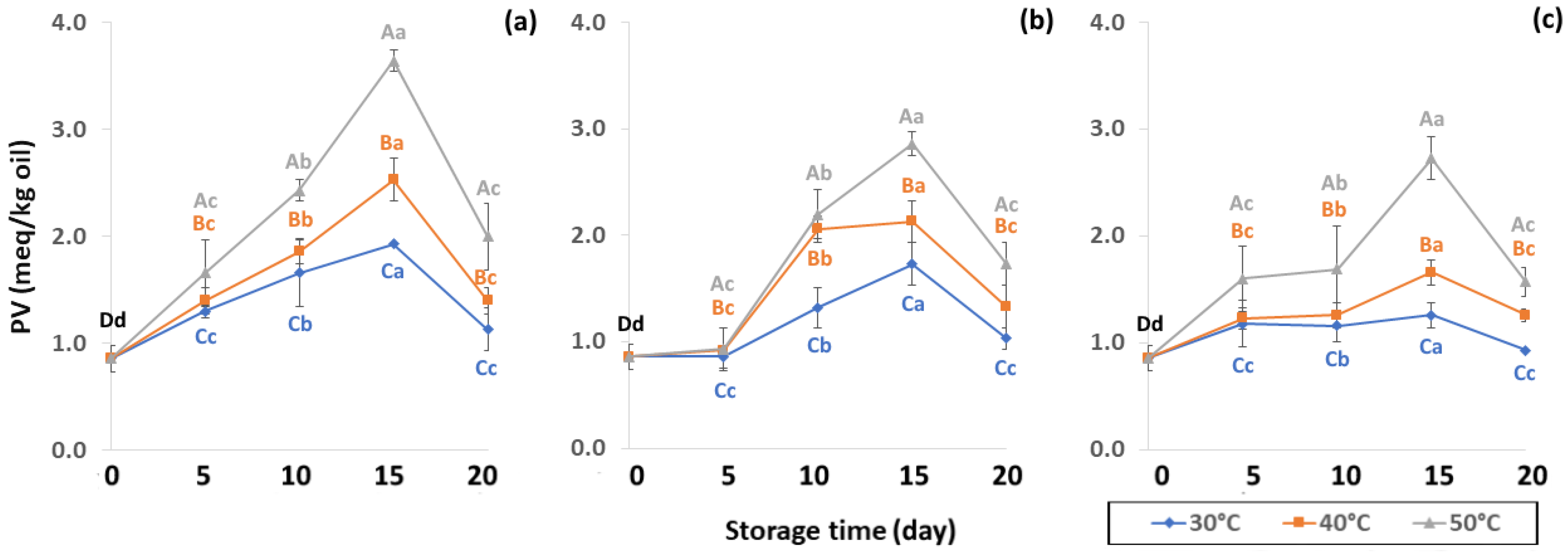
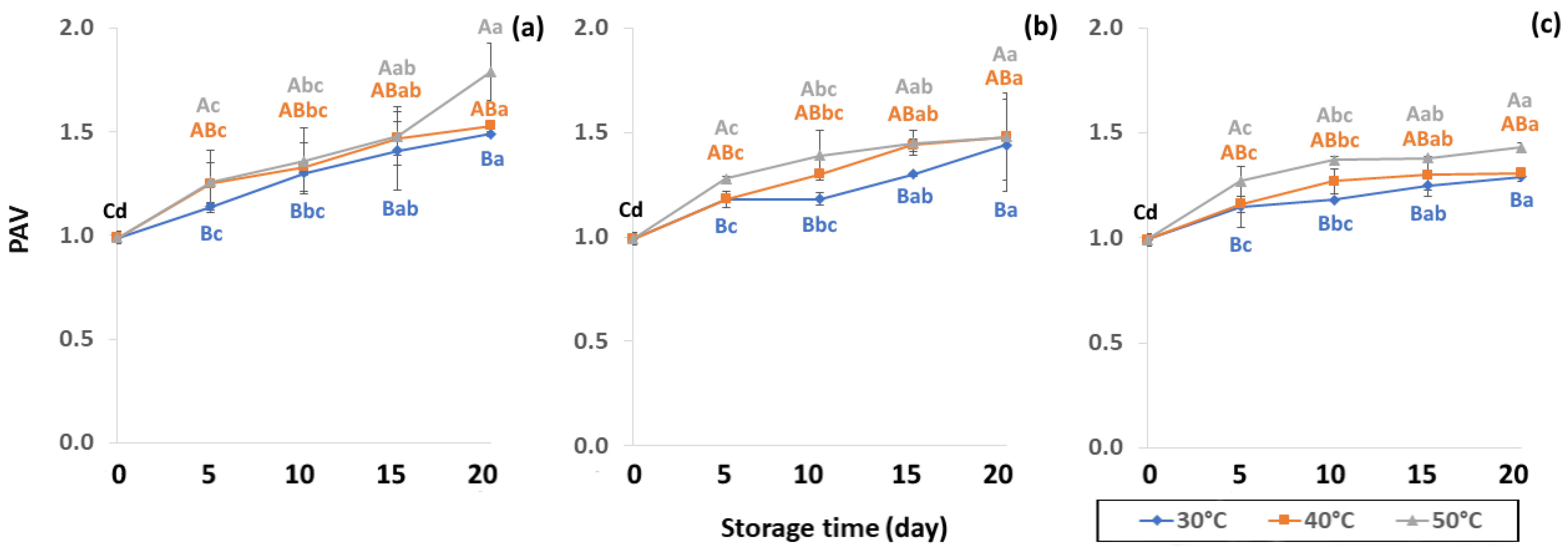
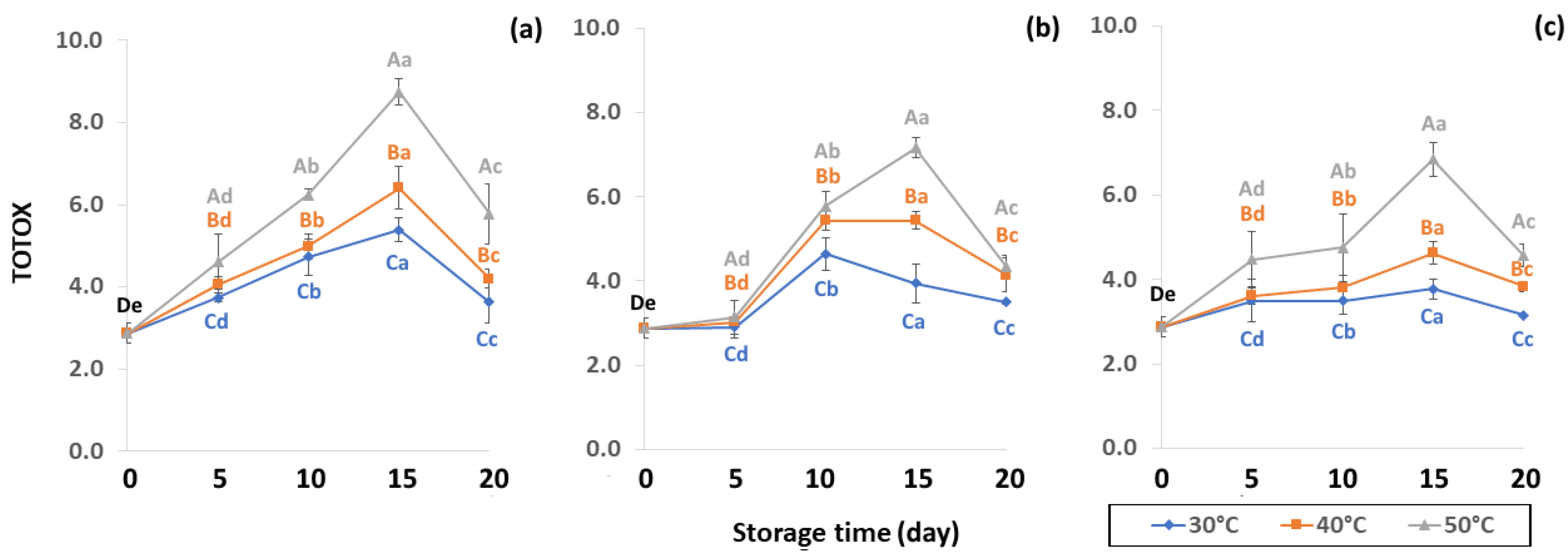

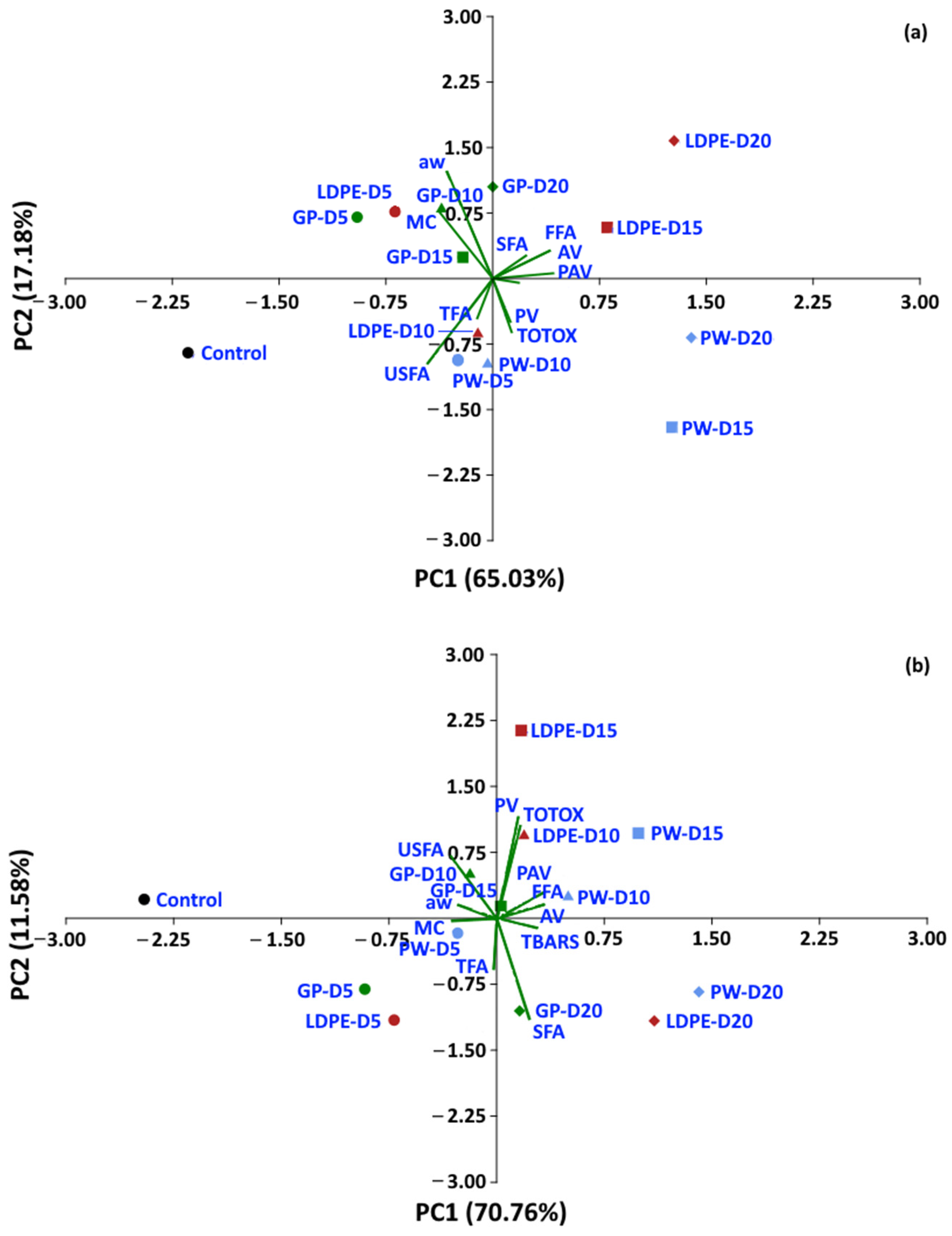
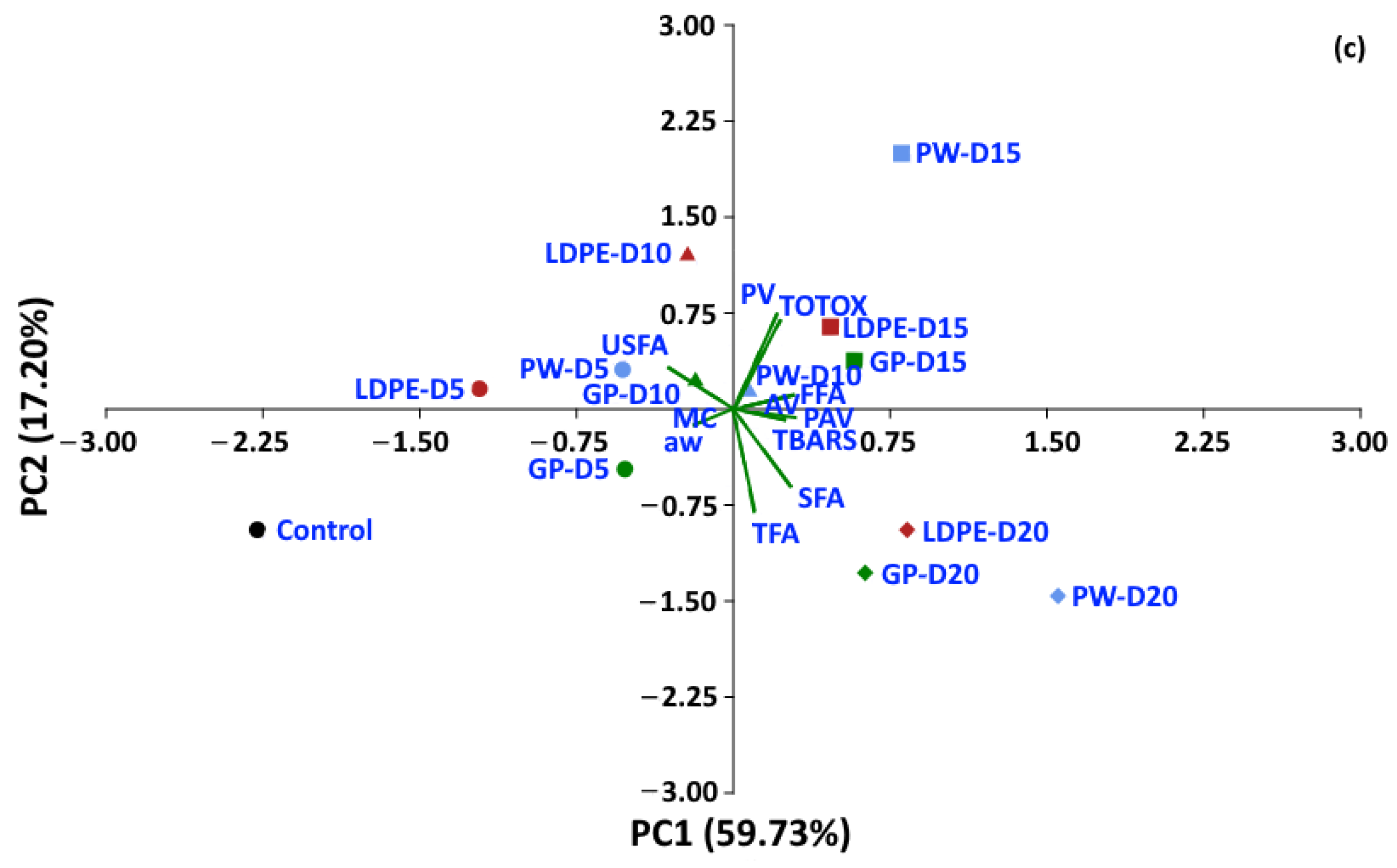
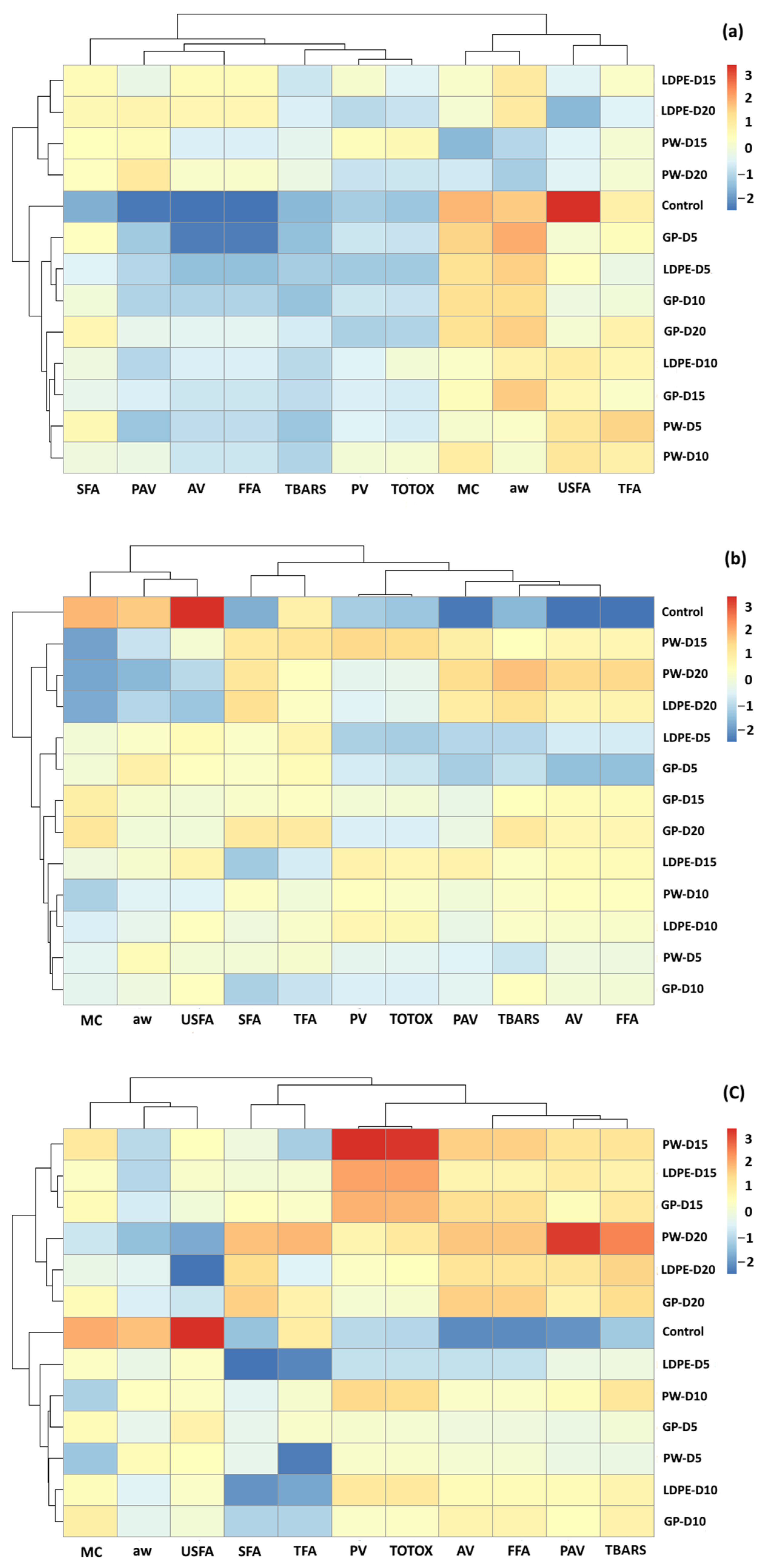
| Packaging | Air Permeability (L/m2 s) | Thickness (mm) | Surface Area (m2) | Supplier |
|---|---|---|---|---|
| PW | 1054.62 ± 4.55 | 0.127 ± 0.00 | 0.0445 | Siam Makro PCL, Bangkok, Thailand |
| LDPE | 101.47 ± 2.70 | 0.075 ± 0.00 | 0.0445 | Siam Makro PCL, Bangkok, Thailand |
| GP | 0.538 ± 0.04 | 0.124 ± 0.00 | 0.0445 | Intergro Co., Ltd., Bangkok, Thailand |
| Fatty Acid (%) | Packaging | Control | 30 °C, 50% RH | 40 °C, 50% RH | 50 °C, 50% RH | |||||||||
|---|---|---|---|---|---|---|---|---|---|---|---|---|---|---|
| Day 0 | Day 5 | Day 10 | Day 15 | Day 20 | Day 5 | Day 10 | Day 15 | Day 20 | Day 5 | Day 10 | Day 15 | Day 20 | ||
| C16:0 | PW | 35.64 ±0.55 Cc | 35.41 ±0.02 Cc | 35.10 ±0.22 Cb | 35.44 ±0.13 Ca | 36.35 ±0.05 Ca | 36.35 ±0.13 BCa | 35.38 ±0.03 BCa | 35.76 ±0.03 BCa | 37.31 ±0.58 BCa | 35.88 ±0.05 Ac | 37.23 ±0.13 Ab | 36.99 ±0.25 Aa | 37.84 34.84 Aa |
| LDPE | 35.65 ±0.06 Cc | 35.53 ±0.08 Cc | 36.06 ±0.37 Cb | 35.18 ±0.04 Ca | 35.66 ±0.71 Ca | 35.21 ±0.22 BCa | 35.19 ±0.71 BCa | 35.83 ±0.21 BCa | 37.49 ±0.36 BCa | 36.04 ±0.04 Ac | 36.81 ±0.41 Ab | 37.76 ±0.08 Aa | 36.79 ±0.07 Aa | |
| GP | 35.66 ±0.06 Cc | 35.31 ±0.04 Cc | 35.12 ±0.04 Cb | 35.60 ±0.06 Ca | 35.19 ±0.05 Ca | 35.76 ±0.04 BCa | 37.32 ±0.19 BCa | 37.11 ±0.01 BCa | 37.01 ±0.04 BCa | 37.60 ±0.02 Ac | 37.01 ±0.04 Ab | 37.23 ±0.05 Aa | 37.24 ±018 Aa | |
| C18:0 | PW | 7.25 ±0.04 Bbc | 8.09 ±0.01 Ab | 7.89 ±0.01 Ac | 8.21 ±0.01 Ac | 8.11 ±0.02 Aa | 7.30 ±0.04 Bb | 7.88 ±0.04 Bc | 6.92 ±0.04 Bc | 7.34 ±0.37 Ba | 6.68 ±0.02 Cb | 6.72 ±0.17 Cc | 6.42 ±0.03 Cc | 7.96 ±0.03 Ca |
| LDPE | 7.25 ±0.04 Bbc | 7.70 ±0.02 Ab | 7.56 ±0.08 Ac | 8.21 ±0.15 Ac | 8.01 ±0.03 Aa | 7.96 ±0.07 Bb | 7.90 ±0.25 Bc | 7.27 ±0.06 Bc | 7.37 ±0.37 Ba | 6.69 ±0.02 Cb | 6.25 ±0.06 Cc | 6.53 ±0.01 Cc | 7.37 ±0.13 Ca | |
| GP | 7.25 ±0.04 Bbc | 8.12 ±0.05 Ab | 8.05 ±0.02 Ac | 7.73 ±0.04 Ac | 8.22 ±0.02 Aa | 7.68 b ±0.01 Bb | 6.44 ±0.06 Bc | 7.07 ±0.02 Bc | 7.50 ±0.50 Ba | 6.47 ±0.01 Cb | 6.45 ±0.02 Cc | 6.85 ±0.05 Cc | 6.97 ±0.07 Ca | |
| C18:1 | PW | 10.00 ±0.14 Aa | 10.07 ±0.07 ABbc | 9.57 ±0.21 ABab | 10.12 ±0.10 ABbc | 9.76 ±0.04 ABc | 9.58 ±0.22 Bbc | 9.71 ±0.05 Bab | 9.30 ±0.23 Bbc | 8.82 ±0.29 Bc | 8.87 ±0.06 Cbc | 9.58 ±0.22 Cab | 9.11 ±0.83 Cbc | 8.95 ±0.46 Cc |
| LDPE | 10.00 ±0.14 Aa | 9.49 ±0.03 ABbc | 9.83 ±0.34 ABab | 9.48 ±0.06 ABbc | 9.45 ±0.11 ABc | 9.35 ±0.11 Bbc | 9.76 ±0.37 Bab | 9.52 ±0.23 Bbc | 9.09 ±0.14 Bc | 8.97 ±0.06 Cbc | 9.23 ±0.05 Cab | 8.80 ±0.08 Cbc | 8.85 ±0.73 Cc | |
| GP | 10.00 ±0.14 Aa | 9.70 ±0.06 ABbc | 9.98 ±0.10 ABab | 9.59 ±0.08 ABbc | 9.84 ±0.51 ABc | 9.86 ±0.02 Bbc | 9.26 ±0.01 Bab | 9.23 ±0.40 Bbc | 8.71 ±0.02 Bc | 8.55 ±0.05 Cbc | 9.55 ±0.05 Cab | 8.82 ±0.39 Cbc | 9.03 ±0.65 Cc | |
| C18:2 | PW | 41.61 ±0.60 Aa | 40.64 ±0.56 Cbc | 41.15 ±0.04 Cab | 39.91 ±0.13 Cbc | 40.28 ±0.56 Cc | 40.69 ±0.31 BCbc | 40.32 ±0.13 BCab | 40.99 ±0.85 BCbc | 41.00 ±0.04 BCc | 41.39 ±0.35 Bbc | 40.72 ±0.03 Bab | 41.25 ±0.17 Bbc | 40.44 ±0.04 Bc |
| LDPE | 41.61 ±0.60 Aa | 40.93 ±0.02 Cbc | 40.82 ±0.26 Cab | 40.58 ±0.04 Cbc | 40.13 ±0.10 Cc | 41.13 ±0.10 BCbc | 40.64 ±0.05 BCab | 41.02 ±0.22 BCbc | 40.61 ±0.04 BCc | 41.33 ±0.02 Bbc | 41.05 ±0.01 Bab | 41.46 ±0.46 Bbc | 40.23 ±0.12 Bc | |
| GP | 41.61 ±0.60 Aa | 40.58 ±0.04 Cbc | 40.22 ±0.07 Cab | 40.75 ±0.10 Cbc | 40.70 ±0.10 Cc | 40.56 ±0.09 BCbc | 40.54 ±0.37 BCab | 41.01 ±0.40 BCbc | 41.01 ±0.01 BCc | 41.80 ±0.01 Bbc | 40.63 ±0.01 Bab | 41.34 ±0.07 Bbc | 40.79 ±0.15 Bc | |
| C20:0 | PW | 3.13 ±0.02 Bb | 3.79 ±0.01 Aa | 3.58 ±0.02 Ab | 3.90 ±0.01 Ab | 3.62 ±0.02 Aa | 3.33 ±0.06 Ba | 3.89 ±0.01 Bb | 2.87 ±0.01 Bb | 2.92 ±0.18 Ba | 2.75 ±0.03 Ca | 2.90 ±0.13 Cb | 2.53 ±0.03 Cb | 2.97 ±0.03 Ca |
| LDPE | 3.13 ±0.02 Bb | 3.42 ±0.01 Aa | 3.28 ±0.12 Ab | 3.89 ±0.03 Ab | 3.63 ±0.01 Aa | 3.93 ±0.07 Ba | 3.82 ±0.20 Bb | 3.15 ±0.11 Bb | 2.81 ±0.15 Ba | 2.69 ±0.10 Ca | 2.61 ±0.05 Cb | 2.57 ±0.01 Cb | 3.49 ±0.41 Ca | |
| GP | 3.13 ±0.02 Bb | 3.73 ±0.01 Aa | 3.78 ±0.02 Ab | 3.47 ±0.01 Ab | 3.92 ±0.02 Aa | 2.55 ±0.02 Ba | 2.91 ±0.02 Bb | 3.00 ±0.01 Bb | 2.60 ±0.03 Ba | 2.75 ±0.01 Ca | 2.98 ±0.05 Cb | 2.98 ±0.05 Cb | 3.51 ±0.47 Ca | |
| SFA | PW | 46.03 ±0.12 Bc | 47.29 ±0.02 Ab | 46.92 ±0.22 Aa | 47.21 ±0.15 Aa | 47.17 ±0.05 Aa | 46.98 ±0.04 Ab | 47.14 ±0.02 Ab | 47.54 ±0.01 Ab | 47.57 ±0.77 Aa | 46.65 ±0.08 Ab | 46.60 ±0.08 Ab | 46.78 ±0.27 Ab | 47.82 ±0.01 Aa |
| LDPE | 46.03 ±0.12 Bc | 46.65 ±0.08 Ab | 46.89 ±0.17 Aa | 47.27 ±0.01 Aa | 47.30 ±0.08 Aa | 47.11 ±0.08 Ab | 46.91 ±0.26 Ab | 46.25 ±0.05 Ab | 47.67 ±0.58 Aa | 45.42 ±0.01 Ab | 45.66 ±0.51 Ab | 46.86 ±0.08 Ab | 47.65 ±0.35 Aa | |
| GP | 46.03 ±0.12 Bc | 47.17 ±0.06 Ab | 46.95 ±0.01 Aa | 46.80 ±0.02 Aa | 47.33 ±0.01 Aa | 47.09 ±0.05 Ab | 46.30 ±0.26 Ab | 47.08 ±0.01 Ab | 47.50 ±0.46 Aa | 46.66 ±0.05 Ab | 46.21 ±0.06 Ab | 47.06 ±0.09 Ab | 47.72 ±0.58 Aa | |
| USFA | PW | 51.61 ±0.74 Aa | 50.71 ±0.49 Bb | 50.71 ±0.17 Bb | 50.03 ±0.04 Bb | 50.04 ±0.52 Bc | 50.27 ±0.53 Bb | 50.03 ±0.08 Bb | 50.29 ±0.80 Bb | 49.83 ±0.25 Bc | 50.36 ±0.41 Bb | 50.31 ±0.25 Bb | 50.36 ±0.66 Bb | 49.39 ±0.50 Bc |
| LDPE | 51.61 ±0.74 Aa | 50.41 ±0.04 Bb | 50.65 ±0.08 Bb | 50.06 ±0.03 Bb | 49.58 ±0.06 Bc | 50.48 ±0.06 Bb | 50.40 ±0.01 Bb | 50.54 ±0.33 Bb | 49.70 ±0.01 Bc | 50.30 ±0.10 Bb | 50.28 ±0.18 Bb | 50.26 ±0.04 Bb | 49.07 ±0.84 Bc | |
| GP | 51.61 ±0.74 Aa | 50.28 ±0.02 Bb | 50.20 ±0.01 Bb | 50.53 ±0.01 Bb | 50.29 ±0.01 Bc | 50.40 ±0.60 Bb | 50.40 ±0.36 Bb | 50.27 ±0.41 Bb | 50.23 ±0.40 Bc | 50.51 ±0.08 Bb | 50.18 ±0.05 Bb | 50.16 ±0.32 Bb | 49.82 ±0.50 Bc | |
| TFA | PW | 97.63 ±0.85 Aa | 97.99 ±0.51 Ab | 97.63 ±0.05 Ab | 97.23 ±0.11 Aab | 97.21 ±0.57 Aab | 97.24 ±0.49 Ab | 97.17 ±0.07 Ab | 97.24 ±0.09 Aab | 97.83 ±0.52 Aab | 97.39 ±0.32 Bb | 97.66 ±0.52 Bb | 97.15 ±0.68 Bab | 98.16 ±0.51 Bab |
| LDPE | 97.63 ±0.85 Aa | 97.06 ±0.12 Ab | 97.54 ±0.09 Ab | 97.32 ±0.02 Aab | 96.88 ±0.15 Aab | 97.59 ±0.09 Ab | 97.30 ±0.58 Ab | 96.79 ±0.06 Aab | 97.36 ±0.06 Aab | 95.72 ±0.75 Bb | 95.94 ±0.09 Bb | 97.12 ±0.55 Bab | 96.72 ±0.06 Bab | |
| GP | 97.63 ±0.85 Aa | 97.44 ±0.01 Ab | 97.14 ±0.01 Ab | 97.33 ±0.02 Aab | 97.62 ±0.02 Aab | 97.49 ±0.55 Ab | 96.70 ±0.62 Ab | 97.35 ±0.40 Aab | 97.74 ±0.07 Aab | 97.17 ±0.13 Bb | 96.39 ±0.02 Bb | 97.22 ±0.23 Bab | 97.54 ±0.08 Bab | |
Publisher’s Note: MDPI stays neutral with regard to jurisdictional claims in published maps and institutional affiliations. |
© 2022 by the authors. Licensee MDPI, Basel, Switzerland. This article is an open access article distributed under the terms and conditions of the Creative Commons Attribution (CC BY) license (https://creativecommons.org/licenses/by/4.0/).
Share and Cite
Aung Moon, S.; Wongsakul, S.; Kitazawa, H.; Saengrayap, R. Lipid Oxidation Changes of Arabica Green Coffee Beans during Accelerated Storage with Different Packaging Types. Foods 2022, 11, 3040. https://doi.org/10.3390/foods11193040
Aung Moon S, Wongsakul S, Kitazawa H, Saengrayap R. Lipid Oxidation Changes of Arabica Green Coffee Beans during Accelerated Storage with Different Packaging Types. Foods. 2022; 11(19):3040. https://doi.org/10.3390/foods11193040
Chicago/Turabian StyleAung Moon, Sai, Sirirung Wongsakul, Hiroaki Kitazawa, and Rattapon Saengrayap. 2022. "Lipid Oxidation Changes of Arabica Green Coffee Beans during Accelerated Storage with Different Packaging Types" Foods 11, no. 19: 3040. https://doi.org/10.3390/foods11193040
APA StyleAung Moon, S., Wongsakul, S., Kitazawa, H., & Saengrayap, R. (2022). Lipid Oxidation Changes of Arabica Green Coffee Beans during Accelerated Storage with Different Packaging Types. Foods, 11(19), 3040. https://doi.org/10.3390/foods11193040








